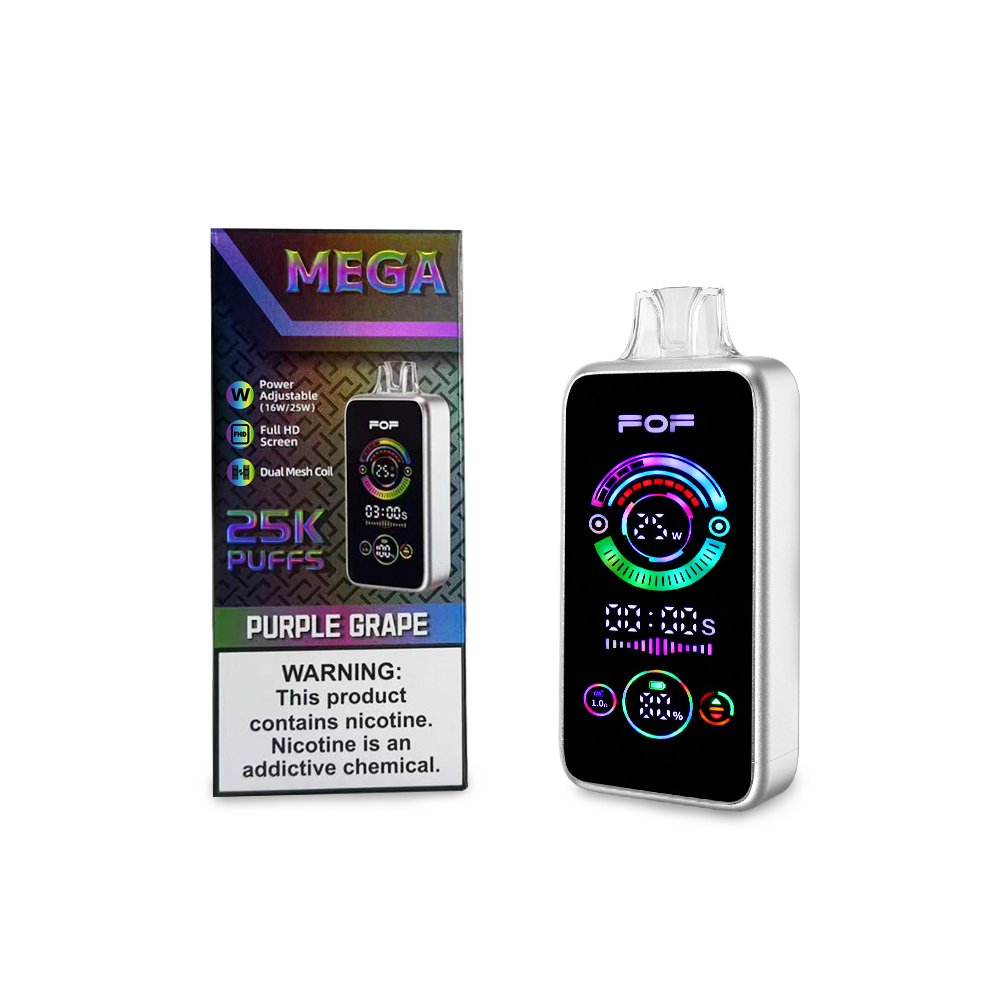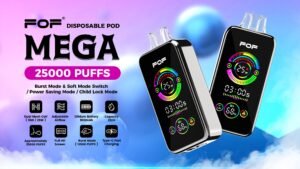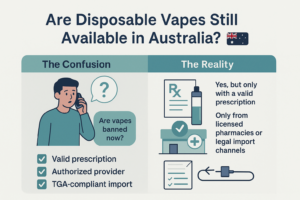Ever wondered what exactly you're inhaling when you use a vape pen? It's not just flavored air. A mix of chemicals goes into creating that vapor, and some of them might surprise you.
Vape pens contain a variety of chemicals, including propylene glycol (PG), vegetable glycerin (VG), flavoring agents, nicotine (in some cases), and potentially harmful substances like heavy metals and volatile organic compounds (VOCs) that can be released during heating.
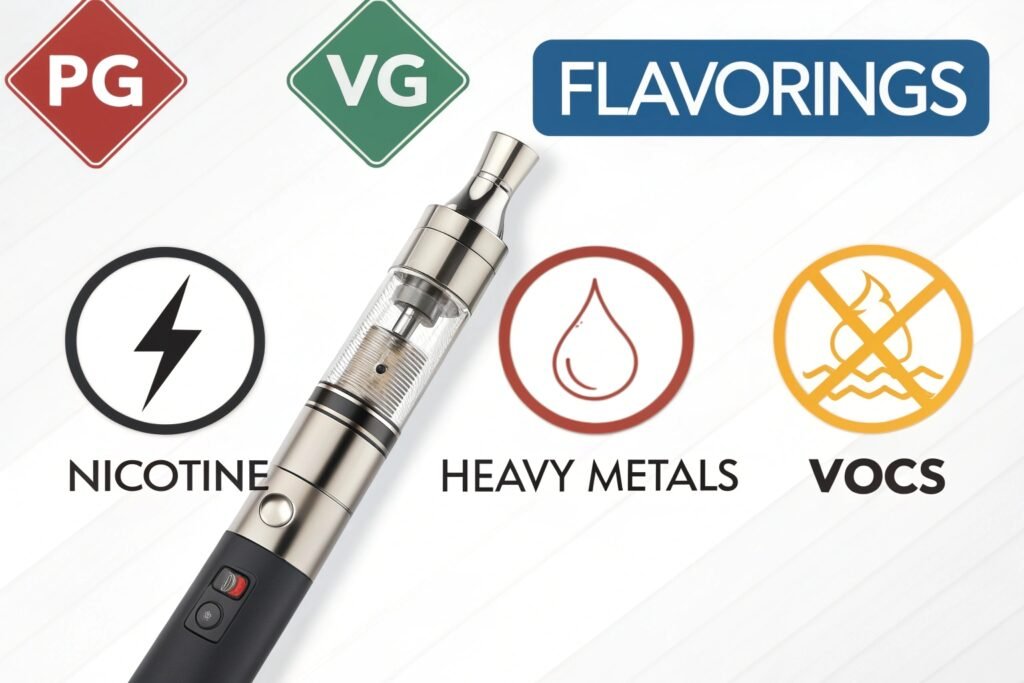 "Close-up of an opened vape pen showing the internal components"
"Close-up of an opened vape pen showing the internal components"
From my experience in the vaping industry, I've learned that understanding these chemicals is key to making informed decisions about vaping. Let's break down what's inside.
What are the harmful chemicals in vapes?
While some chemicals in vapes are considered relatively safe, others pose potential health risks. Knowing the difference can help you make a more informed choice.
Harmful chemicals found in vapes include formaldehyde, acrolein, heavy metals like lead and nickel, volatile organic compounds (VOCs) such as benzene, and ultrafine particles that can be inhaled deep into the lungs. The specific chemicals and their concentrations can vary depending on the type of vape pen and e-liquid used.
 "Illustration showing how vape particles can penetrate deep into the lungs"
"Illustration showing how vape particles can penetrate deep into the lungs"
It's not just about nicotine. Many of these chemicals are byproducts of the heating process or are present in the e-liquid itself. Let's explore these in detail.
The presence of harmful chemicals in vape aerosols1 is influenced by device characteristics, e-liquid composition, and user behavior. Through detailed aerosol analysis and thermal degradation studies, I've identified the following key factors. The device power and temperature settings significantly affect chemical formation – higher power and temperature settings can lead to increased thermal degradation of e-liquid components, resulting in higher levels of harmful chemicals such as formaldehyde, acetaldehyde, and acrolein. The e-liquid flavoring agents can contribute to aerosol toxicity – certain flavoring agents, such as diacetyl and acetyl propionyl, have been linked to respiratory illnesses like bronchiolitis obliterans, while others may form harmful compounds upon heating, necessitating careful selection of e-liquids with minimal additives and potential toxicants. The coil material and design can influence metal release – the coil material (e.g., nichrome, kanthal, stainless steel) and design can influence the release of heavy metals such as nickel, chromium, and lead into the aerosol, emphasizing the importance of using high-quality coils from reputable manufacturers. The wick material and saturation can affect dry puff generation – the wick material (e.g., cotton, silica) and its saturation with e-liquid can affect the generation of dry puffs, which contain higher concentrations of harmful chemicals due to thermal decomposition of the wick material. The air flow and ventilation can impact aerosol concentration – the air flow and ventilation around the vaping device can impact the concentration of harmful chemicals in the aerosol inhaled by the user, emphasizing the importance of vaping in well-ventilated areas.
The toxicological effects of harmful chemicals in vape aerosols on respiratory and cardiovascular health have been extensively studied, revealing potential adverse health outcomes. Through reviewing epidemiological studies and mechanistic investigations, I've identified the following key findings. The respiratory irritation and inflammation2 are commonly observed – exposure to harmful chemicals in vape aerosols can cause respiratory irritation, inflammation, and bronchoconstriction, leading to symptoms such as coughing, wheezing, and shortness of breath, particularly in individuals with pre-existing respiratory conditions. The oxidative stress and cellular damage contribute to long-term health risks – harmful chemicals in vape aerosols can induce oxidative stress and cellular damage in lung tissue, potentially contributing to the development of chronic respiratory diseases such as COPD and asthma. The endothelial dysfunction and cardiovascular effects have been documented – exposure to harmful chemicals in vape aerosols can impair endothelial function, increase blood pressure, and promote the formation of blood clots, potentially increasing the risk of cardiovascular events such as heart attack and stroke. The immune system suppression may increase infection susceptibility – harmful chemicals in vape aerosols can suppress the immune system, increasing susceptibility to respiratory infections such as influenza and pneumonia. The carcinogenic potential raises concerns about cancer risk – certain harmful chemicals in vape aerosols, such as formaldehyde and acetaldehyde, are known carcinogens, raising concerns about the long-term cancer risk associated with vaping, particularly lung cancer and bladder cancer.
The regulatory strategies for mitigating the health risks associated with harmful chemicals in vape aerosols involve product standards, labeling requirements, and public health campaigns3. Through analyzing regulatory frameworks and policy interventions, I've identified the following key approaches. The product standards should limit the concentration of harmful chemicals – product standards should be established to limit the concentration of harmful chemicals in e-liquids and vape aerosols, reducing exposure to potential toxicants and minimizing health risks. The labeling requirements should disclose chemical ingredients and health warnings – labeling requirements should be strengthened to disclose all chemical ingredients in e-liquids and to provide clear health warnings about the potential risks of vaping, promoting informed decision-making. The age restrictions should prevent youth access to vape products – age restrictions should be strictly enforced to prevent youth access to vape products and to protect adolescents from the harmful effects of nicotine and other chemicals in vape aerosols. The public health campaigns should educate the public about vaping risks – public health campaigns should be implemented to educate the public about the potential health risks associated with vaping, particularly among youth and vulnerable populations, promoting prevention and cessation efforts. The research funding should support further investigation of vaping effects – research funding should be increased to support further investigation of the short-term and long-term health effects of vaping, informing evidence-based policies and interventions to protect public health.
Is vape more harmful than smoking?
This is a common question, and the answer isn't always straightforward. Let's compare the risks.
While vaping is often considered less harmful than smoking traditional cigarettes, it is not harmless. Vaping eliminates many of the harmful byproducts of combustion found in cigarette smoke, such as tar and carbon monoxide. However, vape aerosols still contain potentially harmful chemicals, and the long-term health effects of vaping are still being studied.
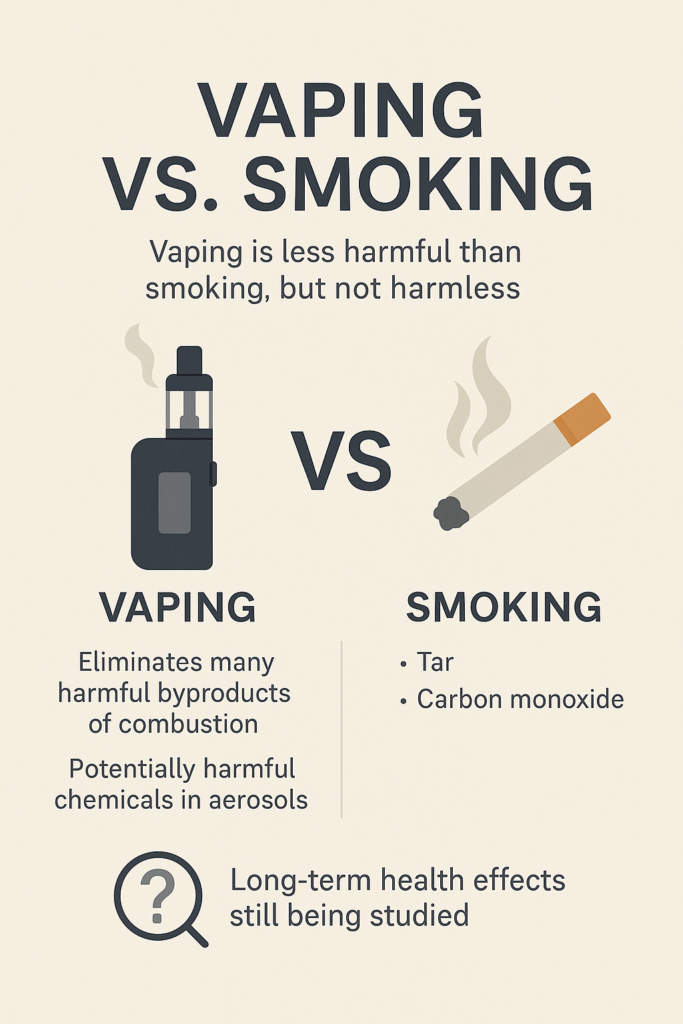 "Side-by-side comparison of a vape pen and a cigarette"
"Side-by-side comparison of a vape pen and a cigarette"
It's a complex comparison, and the risks of vaping shouldn't be dismissed. Let's delve into the specific differences.
The relative harm of electronic cigarettes (e-cigarettes4) compared to combustible cigarettes has been a subject of extensive scientific debate and public health controversy. Through reviewing epidemiological studies and risk assessment models, I've identified the following key considerations. The reduced exposure to combustion byproducts is a primary advantage of e-cigarettes – e-cigarettes eliminate exposure to many of the harmful byproducts of combustion found in combustible cigarettes, such as tar, carbon monoxide, and particulate matter, which are major contributors to smoking-related diseases. The lower levels of nicotine exposure may reduce addiction potential – e-cigarettes may deliver lower levels of nicotine compared to combustible cigarettes, potentially reducing the risk of nicotine addiction and dependence. The potential for harm reduction depends on complete switching from smoking – the potential for harm reduction from e-cigarettes is contingent upon complete switching from combustible cigarettes, as dual use of both products may negate any potential health benefits. The long-term health effects of e-cigarette use remain largely unknown – the long-term health effects of e-cigarette use are still being studied, and there is limited evidence to assess the potential risks associated with chronic exposure to e-cigarette aerosols, particularly among youth and never-smokers. The renormalization of smoking behavior poses a public health concern – the increasing popularity of e-cigarettes, particularly among youth, may renormalize smoking behavior and undermine tobacco control efforts, potentially leading to increased initiation of combustible cigarettes.
The specific health risks associated with e-cigarette use include respiratory effects, cardiovascular effects, and potential carcinogenic effects. Through reviewing clinical studies and toxicological investigations, I've identified the following key concerns. The respiratory irritation and inflammation are commonly reported – e-cigarette use can cause respiratory irritation, inflammation, and bronchoconstriction, leading to symptoms such as coughing, wheezing, and shortness of breath, particularly in individuals with pre-existing respiratory conditions. The EVALI outbreak5 highlighted the dangers of unregulated e-cigarette products – the e-cigarette, or vaping, product use associated lung injury (EVALI) outbreak in 2019 highlighted the dangers of unregulated e-cigarette products, particularly those containing vitamin E acetate as a thickening agent. The cardiovascular effects of e-cigarette use are being investigated – e-cigarette use may exert cardiovascular effects such as increased heart rate, blood pressure, and arterial stiffness, potentially increasing the risk of cardiovascular events. The potential carcinogenic effects of e-cigarette aerosols warrant further scrutiny – e-cigarette aerosols contain potentially carcinogenic chemicals such as formaldehyde, acetaldehyde, and acrolein, raising concerns about the long-term cancer risk associated with e-cigarette use. The second-hand exposure to e-cigarette aerosols poses a risk to bystanders – second-hand exposure to e-cigarette aerosols may pose a risk to bystanders, particularly children and pregnant women, due to the inhalation of nicotine and other potentially harmful chemicals.
The regulatory and public health strategies for managing the risks associated with e-cigarettes include product regulation, age restrictions, and public education campaigns. Through analyzing regulatory frameworks and policy interventions, I've identified the following key approaches. The product standards should ensure e-cigarette safety and quality – product standards should be established to ensure the safety and quality of e-cigarettes, including requirements for ingredient disclosure, testing for contaminants, and device performance. The age restrictions should prevent youth access to e-cigarettes – age restrictions should be strictly enforced to prevent youth access to e-cigarettes and to protect adolescents from the harmful effects of nicotine and other chemicals in e-cigarette aerosols. The marketing restrictions should limit e-cigarette advertising and promotion – marketing restrictions should be implemented to limit e-cigarette advertising and promotion, particularly targeting youth, and to counter the glamorization of vaping. The public health campaigns should educate the public about the risks of e-cigarettes – public health campaigns6 should be conducted to educate the public about the potential health risks associated with e-cigarettes, particularly among youth and vulnerable populations, promoting informed decision-making. The research funding should support further investigation of e-cigarette effects – research funding should be increased to support further investigation of the short-term and long-term health effects of e-cigarette use, informing evidence-based policies and interventions to protect public health.
What 5 chemicals are in vaping cartridges?
Breaking down the common chemicals in vape cartridges can provide a clearer picture of what you're inhaling.
Five common chemicals found in vaping cartridges are: 1) Propylene glycol (PG), 2) Vegetable glycerin (VG), 3) Nicotine (in nicotine-containing cartridges), 4) Flavoring agents (such as diacetyl and acetyl propionyl), and 5) Cannabinoids (like THC or CBD, depending on the cartridge type).
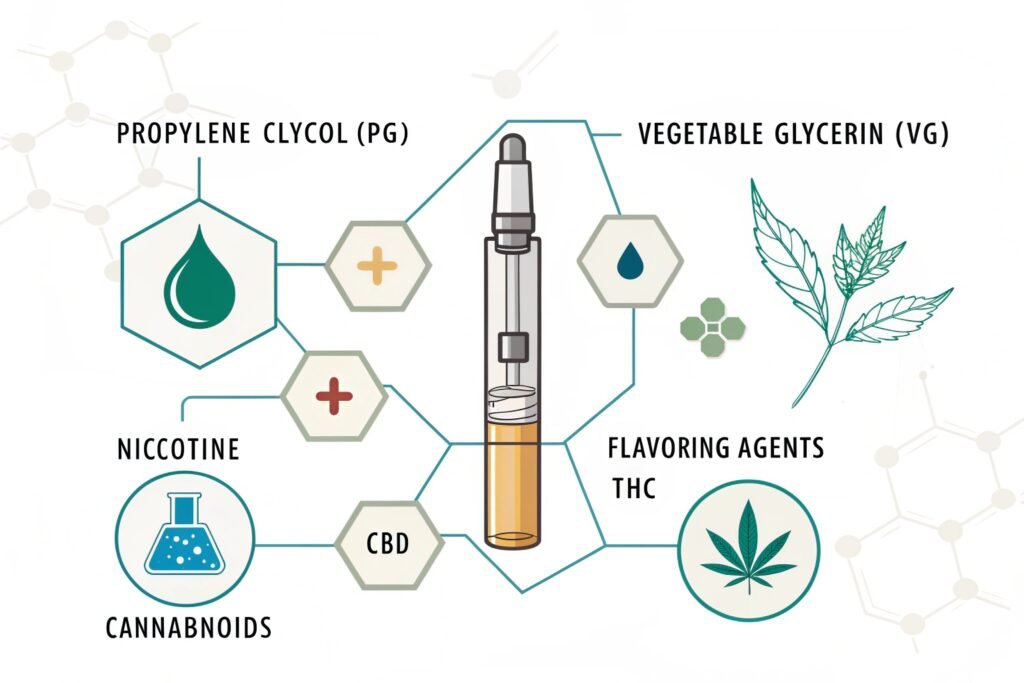 "Chemicals separated in layers within a vaping cartridge"
"Chemicals separated in layers within a vaping cartridge"
Let's take a closer look at each of these and what they do.
The chemical composition of vaping cartridges varies depending on the type of product (e.g., nicotine e-liquids, THC cartridges, CBD cartridges) and the specific formulation used by the manufacturer. Through analyzing laboratory test results and product specifications, I've identified the following key chemical components. The propylene glycol (PG)7 serves as a solvent and aerosol carrier – PG is a synthetic organic compound that is commonly used as a solvent and aerosol carrier in e-liquids, facilitating the vaporization of other ingredients and delivering a "throat hit" sensation similar to smoking. The vegetable glycerin (VG) contributes to vapor production and smoothness – VG is a natural polyol derived from plant oils that is used to produce dense, voluminous vapor clouds and to create a smoother, less harsh vaping experience. The nicotine (in nicotine e-liquids) provides addictive effects – nicotine is an addictive alkaloid derived from tobacco plants that is added to e-liquids to provide the reinforcing effects associated with smoking, with concentrations typically ranging from 0 mg/mL to 50 mg/mL. The flavoring agents enhance taste and appeal – flavoring agents encompass a wide range of natural and synthetic chemicals that are added to e-liquids to create appealing taste profiles, such as fruit, candy, or dessert flavors, but some flavoring agents have been linked to respiratory illnesses. The cannabinoids (THC or CBD) deliver psychoactive or therapeutic effects – THC (tetrahydrocannabinol) is the psychoactive compound in cannabis that produces the "high" associated with marijuana use, while CBD (cannabidiol) is a non-psychoactive cannabinoid that is marketed for its potential therapeutic benefits, such as pain relief and anxiety reduction.
The potential health risks associated with the chemical components of vaping cartridges depend on the specific chemicals involved and the extent of exposure. Through reviewing toxicological studies and clinical research, I've identified the following key concerns. The respiratory irritation and inflammation can be caused by PG and VG – PG and VG can cause respiratory irritation, inflammation, and bronchoconstriction, leading to symptoms such as coughing, wheezing, and shortness of breath, particularly in individuals with pre-existing respiratory conditions. The nicotine addiction8 and cardiovascular effects are well-documented – nicotine is highly addictive and can exert adverse cardiovascular effects, such as increased heart rate, blood pressure, and arterial stiffness, increasing the risk of heart attack and stroke. The flavoring agent toxicity9 raises concerns about respiratory illness – certain flavoring agents, such as diacetyl and acetyl propionyl, have been linked to bronchiolitis obliterans, a serious respiratory illness characterized by scarring and inflammation of the small airways in the lungs. The THC exposure can impair cognitive function and mental health – THC exposure can impair cognitive function, memory, and attention, and it may exacerbate symptoms of mental health disorders, such as anxiety, depression, and psychosis. The CBD effects are still under investigation – while CBD is generally considered safe, its long-term health effects and potential interactions with other medications are still being investigated, necessitating caution and further research.
The regulatory oversight of vaping cartridges varies depending on the jurisdiction and the type of product involved (e.g., nicotine e-liquids, THC cartridges, CBD cartridges). Through analyzing regulatory frameworks and policy interventions, I've identified the following key approaches. The product standards should ensure safety and quality – product standards should be established to ensure the safety and quality of vaping cartridges, including requirements for ingredient disclosure, testing for contaminants, and device performance. The age restrictions should prevent youth access – age restrictions should be strictly enforced to prevent youth access to vaping cartridges and to protect adolescents from the harmful effects of nicotine, THC, and other chemicals. The licensing and taxation should regulate the sale and distribution of vaping cartridges – licensing and taxation should be used to regulate the sale and distribution of vaping cartridges, ensuring that retailers comply with age restrictions and other regulations and generating revenue for public health programs. The public health campaigns should educate the public about vaping risks – public health campaigns should be conducted to educate the public about the potential health risks associated with vaping cartridges, particularly among youth and vulnerable populations, promoting prevention and cessation efforts. The research funding should support further investigation of vaping effects – research funding should be increased to support further investigation of the short-term and long-term health effects of vaping cartridges, informing evidence-based policies and interventions to protect public health.
Is propylene glycol toxic to vape?
Let's address the concerns around propylene glycol and its toxicity when vaped.
Propylene glycol (PG) is generally considered safe for ingestion, but when vaporized and inhaled, it can cause respiratory irritation in some people. Studies have shown that PG can break down into harmful carbonyl compounds at high temperatures. While not acutely toxic, it's a potential irritant and source of concern.
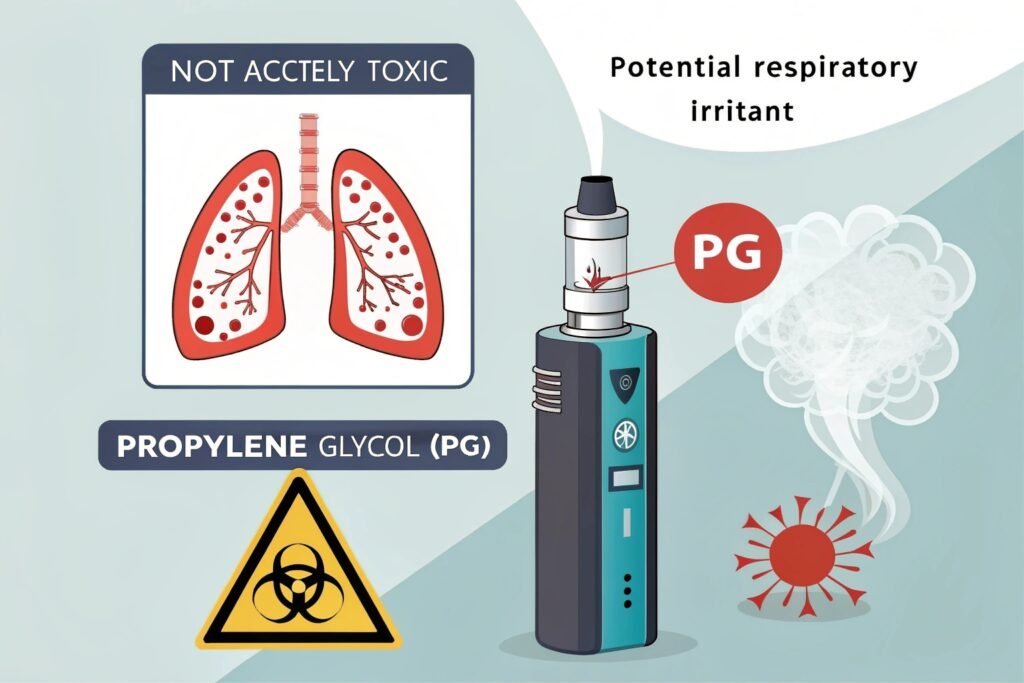 "Illustration of a propylene glycol molecule with a red warning sign"
"Illustration of a propylene glycol molecule with a red warning sign"
Knowing the details about PG can help you make informed choices about vaping. Let's dive deeper.
The potential toxicity of propylene glycol (PG) aerosols in electronic cigarettes (e-cigarettes) has been a subject of ongoing scientific investigation and public health concern. Through reviewing toxicological studies and clinical research, I've identified the following key areas of inquiry. The respiratory irritation10 and inflammation are well-documented – PG inhalation can cause respiratory irritation, inflammation, and bronchoconstriction in susceptible individuals, potentially exacerbating pre-existing respiratory conditions such as asthma or chronic obstructive pulmonary disease (COPD). The carbonyl compound formation upon heating poses a significant concern – PG can undergo thermal degradation upon heating in e-cigarettes, producing carbonyl compounds such as formaldehyde, acetaldehyde, and acrolein, which are known carcinogens and respiratory irritants. The allergic reactions and hypersensitivity responses have been reported – some individuals may experience allergic reactions or hypersensitivity responses to PG inhalation, manifesting as skin rashes, hives, angioedema, or anaphylaxis, requiring prompt medical attention. The mucociliary clearance impairment may increase infection risk – PG inhalation can impair mucociliary clearance, the natural defense mechanism of the respiratory system, potentially increasing susceptibility to respiratory infections and exacerbating existing lung diseases. The cardiovascular effects require further investigation – while limited evidence suggests cardiovascular effects from PG inhalation, further research is needed to assess potential risks such as increased heart rate, blood pressure, or arrhythmias.
The factors influencing the toxicity of propylene glycol (PG) aerosols in e-cigarettes include device characteristics, user behavior, and environmental conditions. Through analyzing aerosol chemistry and exposure dynamics, I've identified the following key determinants. The device power and temperature settings significantly influence carbonyl formation – higher power and temperature settings can increase the thermal degradation of PG and the formation of harmful carbonyl compounds, emphasizing the importance of using low-power devices with temperature control features. The e-liquid composition11 and flavoring agents can modulate PG toxicity – the presence of certain flavoring agents or additives in e-liquids can interact with PG and alter the formation of harmful compounds upon heating, necessitating careful selection of e-liquids with minimal additives and potential toxicants. The puff topography and inhalation patterns affect exposure levels – the frequency, duration, and intensity of puffing and inhalation patterns can significantly influence the amount of PG aerosol inhaled and the resulting exposure levels, emphasizing the importance of moderate vaping behavior. The ventilation conditions and indoor air quality can impact aerosol dispersion – poor ventilation conditions and indoor air quality can prolong the residence time of PG aerosols in the air, increasing the potential for passive exposure to non-vapers, particularly children and pregnant women. The individual susceptibility and pre-existing health conditions can modify PG responses – individuals with pre-existing respiratory conditions, allergies, or sensitivities may be more susceptible to adverse effects from PG inhalation, highlighting the need for personalized risk assessment and informed decision-making.
The strategies for mitigating the potential risks associated with propylene glycol (PG) inhalation in e-cigarettes encompass product regulation, public education, and individual behavior modification. Through reviewing evidence-based interventions and best practices, I've identified the following key approaches. The regulatory standards for e-liquid composition and device safety should be strengthened – regulatory standards should be strengthened to limit the concentration of PG and other potentially harmful ingredients in e-liquids and to ensure the safety and performance of e-cigarette devices, including temperature control features. The public health campaigns should raise awareness about PG risks – public health campaigns should be implemented to raise awareness about the potential health risks associated with PG inhalation in e-cigarettes, particularly among youth and vulnerable populations, promoting informed decision-making. The healthcare provider counseling should address vaping risks – healthcare providers should be trained to counsel patients about the potential risks of vaping, including PG inhalation, and to provide guidance on smoking cessation and harm reduction strategies. The youth prevention programs should target e-cigarette use – youth prevention programs should be implemented to discourage e-cigarette use and to educate adolescents about the potential health risks associated with vaping, including PG inhalation, promoting healthy lifestyle choices. The smoke-free policies should extend to e-cigarettes – smoke-free policies should be extended to include e-cigarettes in public places and workplaces to minimize passive exposure to PG aerosols and to denormalize vaping behavior.
Conclusion
Vape pens aren't just harmless vapor. They contain a mix of chemicals with potential risks. Staying informed about these chemicals and making smart choices is essential for protecting your health.
-
Understanding the harmful chemicals in vape aerosols is crucial for making informed decisions about vaping and its health risks. ↩
-
Exploring the link between vape aerosols and respiratory issues can help users recognize the potential health risks associated with vaping. ↩
-
Learning about successful public health campaigns can provide insights into how to effectively communicate the risks of vaping to the public. ↩
-
Understanding the health risks of e-cigarettes is crucial for making informed decisions about their use and potential impacts on public health. ↩
-
Exploring the EVALI outbreak provides insight into the dangers of unregulated vaping products and their health consequences. ↩
-
Investigating the effectiveness of public health campaigns can reveal strategies to better inform the public about vaping risks and promote healthier choices. ↩
-
Understanding PG's role in vaping can help you make informed choices about e-liquids and their effects on health. ↩
-
Exploring the health effects of nicotine addiction can provide insights into its risks and help in making informed decisions about vaping. ↩
-
Learning about flavoring agent toxicity can help you understand potential health risks and make safer choices when vaping. ↩
-
Exploring the causes of respiratory irritation can help you recognize symptoms and make safer choices regarding vaping. ↩
-
Learning about e-liquid composition can guide you in selecting safer vaping products and avoiding harmful additives. ↩

